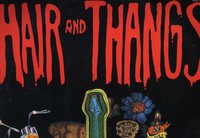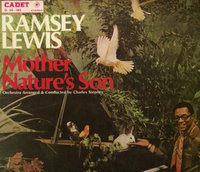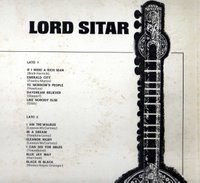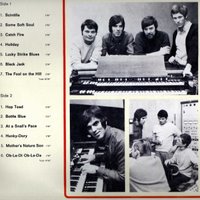interview with Antonello Vannucchi I Marc 4
Interview with Antonello Vannucchi.


During his career Antonello Vannucchi has performed with artist such as Chet Baker, Barney Kassel, Bobby Hackett, Kenny Clarke, Lee Konitz. Vannucchi, often pianist for Minnie Minoprio, also accompanied some of the great performers of Italian music from Mina to Ornella Vanoni.
Vannucchi also recorded “beat” songs for Ariston Records under the name of I 4 di Lucca later known as the great Marc 4.The name comes from the acrostic of the names of the founders (Maurizio, Antonello, Roberto, Carlo), all musicians wo were part of the Italian State Television (RAI) Orchestra. Essentially a studio band, because of the considerable technical ability of the single players, Marc 4 began to collaborate with the most prestigious authors of film scores : Ennio Morricone, Nino Rota, Armando Trovajoli, Gianni Ferrio, Piero Piccioni, Piero Umiliani, Alessandro Alessandroni to name a few. At times the guitarist Bruno Battisti D'Amario also collaborated with them.

Later the group began to produce their own material which had its origins in the beat style but later developed more into bossa nova and jazz, They recorded a few LP's and singles which are now very rare and sought after.
The principle characteristic of their sound was Vannucchi's Hammond organ. They also worked on TV themes, for example with Mooke/Simona, the theme tune to the program Controfatica, and also the two singles Tema di Nino/Romanza Popolare, which in 1974 were used as the theme tune for a television series about a doctor.
The single players also had a significant career as session musicians.
Where does your unmistakeable style of jazz come from? Who were your favourite musicians and how did they influence you at the beginning of your career?
I was fascinated by BeBop. Miles Davis was the one that opened up my listening to jazz music. I remember a 78rpm called “Down "or something like that , I cannot remember well .
Dizzy Gillespie,Clark Terry , Ray Brown and Bud Powell also influenced my taste, I loved bop from the 40's and 50's. I wanted to use two saxes to recreate that typical sound, the Bebop sound.
You played for a long period with the RAI Orchestra, accompanying the queens of italian music such as Mina and Vanoni. Was it easy to get into RAI and play with such an orchestra?
I played with the Rai Orchestra from 1965 to 1995, I played with Mina, Vanoni and the Kessler Sisters. We also created a small combo that played with them when they toured. We played many concerts, in Europe and beyond.
Tell me about the fabulous group “I Marc 4”. How did they come about?


“I Marc 4” came together in the early 70's. We played on many film scores, we were session men, let's say.
At times, the music director Trovajoli like also Umiliani or Piccoli, asked us, in certain particular moments of a film, to create sounds that appealed to our taste, commentary music (library)
And from that the idea of recording these “commentaries” or other pieces under the name of “I Marc 4”.
The name derives from the initials of our names Carlo Pes, Maurizio Majorana, Roberto Podio and me Antonello Vannucchi.
The Serni label produced these records that were later used as library music on “Cronache Italiane” etc..

When you were writing pieces for soundtracks, surely you had more room to move creatively. Did you have a catalogue of pieces already composed or did you compose according to request and demand?
Most of the times they would give us some themes and we would create ad hoc soundscapes.
“I Marc 4” were defined as the “Trovajoli Soloists”. Other than with this Musical Director you also worked with composers such as Ennio Morricone, Nino Rota, Gianni Ferrio, Piero Piccioni, Piero Umiliani, Alessandro Alessandroni.. How were you taken on or engaged. You were in high demand at the time...
Let's say that our sound was in demand,. We had an Hammond Organ and our sound was inspired by Jimmy Smith, this was the early 70's.
We could say that you were the rhythm session of the Italian theme music.
Exactly!! And we were also the rhythm session for the RAI Orchestra
At times you composed under other names. How come?
Being a part of RAI, myself Podio and Majorana, according to contract, we could not have a dual role and so when we were asked for a piece of library music, we'd record them under made up names or friends names in order to get round the problem of not being able to be under dual obligation. The names used were De Luca , Edmundo Rossi , Romolo Grano etc...
Which Musical Director was able to acknowledge your renown jazz vein?

Trovajoli for sure. He was a jazz player in his own right. Piccioni also loved jazz. He was very eccentric. !
You also played with jazz legends from overseas such as Chet Baker, Barney Kassel, Bobby Hackett, Kenny Clarke, Lee Konitz.
Was there a difference between playing with foreign musicians who were strictly jazz and Italian composers who had a background of classical or popular music?
When Baker came out of prison in Lucca in 1965, he came knocking straight at my door. We decided to form a group to accompany him during his concerts. We did this for quite a long time during his stay in Italy. The group was composed by me on vibraphone, Baker on trumpet, Andrea Tommaso on double bass and Franco Mondini on drums.
Mina, The Kesslers Sisters, “La Bussola”. What was the atmosphere like in Rome in the early 70's ?
The atmosphere was fantastic and always electric.
Do you ever listen by chance, to some theme tune which you played on or some recording by Marc 4 ?



Yes I still have all the vinyl records of our work and every now and again I listen to them. I know them off by heart by now.
What do you think about the desire that there is now (in the last few years) to look for, listen and even dance to that music.?
Naturally it pleases me ! I think that the music that we did then is very close to that which the young people listen to today, so it not difficult to see why they appreciate that type of music.
Labels: alessio berto, bossanova, brazil, cinedelic, ennio morricone, hammond, jazz, jazzmotel, morricone, sitar, soundtracks

















